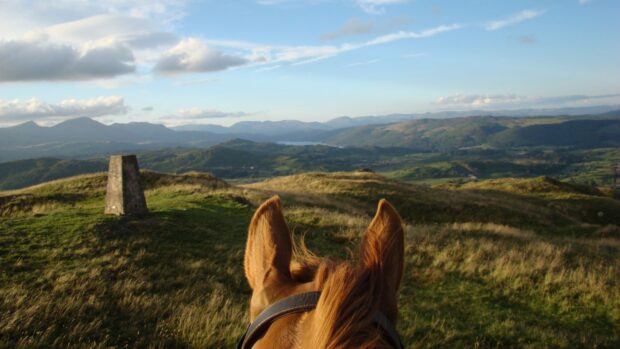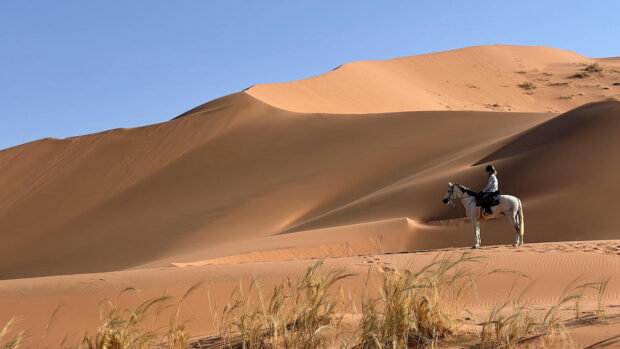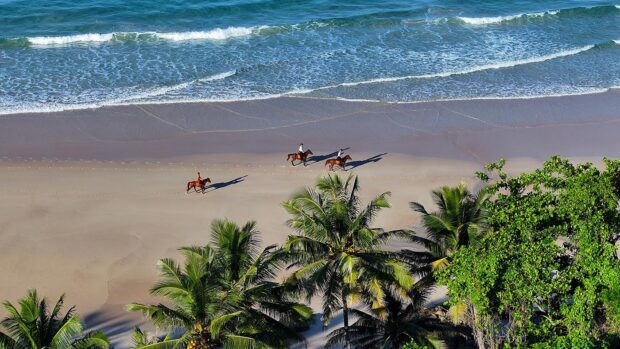The fabled horses of Sable Island have a long and somewhat unknown and controversial story, says Lisa Young. Here's all you need to know about them — from how they ended up there, to how they survive today
1. Sable Island is a tiny sand bar, an ecologically sensitive island measuring 42 kilometres long and 1.5 kilometres wide and located 250 kilometres south east of Nova Scotia, Canada.
2. Over the centuries, 350 shipwrecks were recorded off Sable Island until modern navigation was invented. The island gained the name of the Graveyard of the North Atlantic, with many mariners buried among the islands sand dunes.
3. The first known visit was by Portuguese explorers in 1520–21. Crews from American, French and British ships came to the island, intentionally or accidentally. Some came to profit from the shipwrecks. There were attempts to colonise or farm the land, and the French even attempted to house convicts on the island.
4. Along with other animals, the horses were introduced to the island in 1737 by a Boston preacher called Andrew Le Mercier, to provide food for shipwrecked and stranded mariners.
5. In 1760, a Boston merchant called Thomas Hancock introduced 60 more horses to the island. Hancock’s horses are believed to have been confiscated from expelled Acadians; they were French settlers who lived in Acadia, what is known today as Canada’s Maritime Provinces of New Brunswick, Nova Scotia and Prince Edward Island.
6. It is believed that the horses wandering the island today are most likely descendants of horses that were seized by the British from the Acadians during their expulsion from Nova Scotia in the late 1750s and 1760s.
7. Hancock planned to develop a livestock business on the remote sand bar with horses, sheep, cows, goats and pigs. The idea was to let the animals take care of themselves, reproduce, and increase in numbers before being sold off at market. However, the idea was abandoned and only the horses survived long term under the tough weather conditions.
8. In 1801 a lifesaving station was built to help save mariners from the perils of the sea. The horses were put to work and used to pull lifeboats to and from the water, and they were ridden along the island’s shore looking for ships in distress. A lighthouse was built, and later a weather station introduced.
9. Today, just a handful of researchers and Parks Canada staff live a few months at a time on the island. Not many people get to the island due to its inaccessibility and geographical remoteness. The complex and dynamic currents, heavy fog and constant wave action batter the island from all directions daily. These elements keep visitors to a minimum.
10. The island is accessible by boat or by private plane that is small enough to land on a thin stretch of beach. You cannot sleep on the island and approximately 50 to 250 visitors a year make it across the tricky waters to see the wild horses.
11. Parks Canada is now the appointed custodian of the horses and fully protected by law.
12. Nothing originated on the island. The only terrestrial mammals living here are 550 feral horses — this figure fluctuates each year.
13. The horses have never received modern veterinary care, antibiotics or other medicine.
14. Back in the 1950s biologists reported that the horses were destroying the islands sensitive ecology. Plans were made by the Canadian government to remove them to the mainland where they would be used as pit ponies in mines, or destined for slaughterhouses. The news hit the papers and Canadian school children wrote protest letters to their Prime Minister and eventually swayed the government to save the horses, even changing the Canadian Shipping Act. “No person shall, without having first obtained written permission, molest, interfere with, feed or otherwise have anything to do with the ponies on Sable Island.”
15. People often refer to the wild horses as ponies due to their small size (approximately 14 hands high), which is due to the lack of nutrients. However, they have a horse phenotype and an ancestry of horses only.
16. Rain seeps through the sand until it meets salt water. Fresh water floats on top of salt water and the horses know where to dig in the sand until small pools of water fill the hole. There are fresh water pools on the island too and this is a lifesaving source for the horses.
17. The horses’ manes are so long and wild looking they touch the ground, while their tails drag along the ground and their hooves grow long and sometimes turn up.
18. They have very thick and shaggy coats and are well adapted to the conditions of Sable Island.
19. The horses adapted to their conditions and eat coarse Marram grass and its been reported they have been seen eating seaweed.
20. The horses grow fat in the summer months, but in the winter they become lean.
21. Because there is a lot of sand in the grass and in their diet generally, it wears down their teeth over the years and some older horses starve because they can’t feed properly. The average age of the Sable Island horses is between 5 to 10 years of age, short for a horse.
22. Some argue that leaving the horses on the island is cruel and they digest sand from the grass, and that the horses were brought to the island’s inhospitable environment where they have such short odds, and they should be removed to the mainland. They have adapted to the islands conditions, and are a recognised breed and considered wild horses.
23. Around 40 to 50 small herds roam the island. The herd consists of a stallion, a few mares and young, and possibly young colts, but they are kicked out of the herd when it is time to mate.
24. Some people acknowledge the horses don’t belong on the island, yet admire the fact they survived so long without human help.
25. They have survived for 250 years against all odds and without human interference.
26. The horses share the island with the worlds largest grey seal colony and various rare birds, and they can often be seen curiously interacting with the seals.
Like this? You might also enjoy reading these:
Dog room service and four-poster beds: is this the most luxurious place to stay for Burghley?
Heading off on a hot riding holiday? 11 tips for keeping cool
27. You can visit the island with Adventure Canada, spending four days anchored off the island and sleeping and eating on the ship, with daily visits by zodiac to see the horses and explore the island’s history.
28. To protect the horses, Parks Canada require visitors to keep 50 metres away from them, but if a horse comes up to you, you are advised to slowly move away — but not before taking a photo of the spectacular animal.
29. Questions will always be raised about the welfare of the horses, but for now they roam the sand bar in the Atlantic, where, on a good weather day you’d think you were in the Caribbean.
Getting to Sable Island
Lisa Young travelled with Adventure Canada by ship to Sable Island. To book visit www.adventurecanada.com.
To find out more about exploring Canada visit www.explore-canada.co.uk



